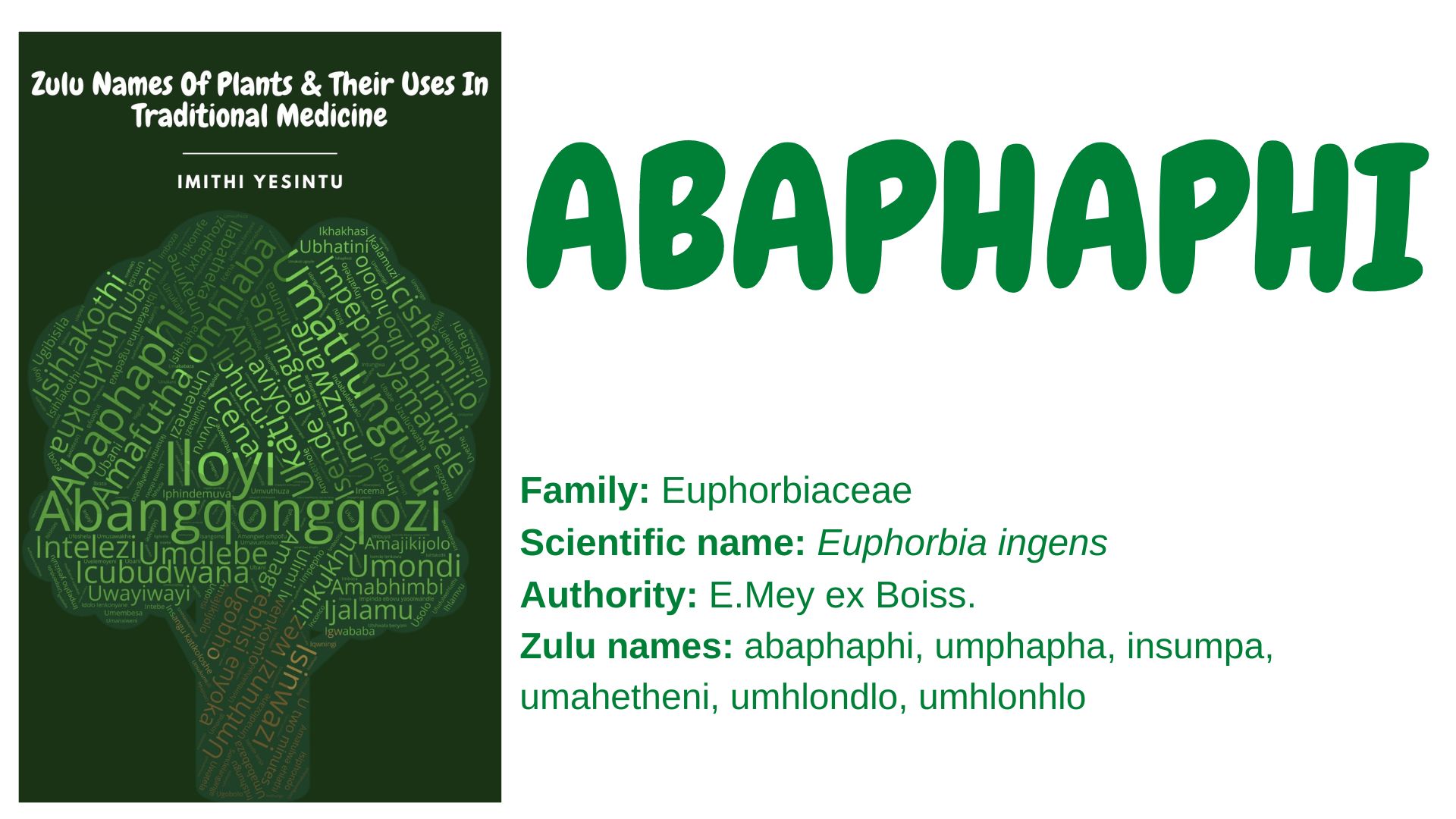Family: Euphorbiaceae
Scientific name: Euphorbia ingens
Authority: E.Mey ex Boiss.
Synonyms: Euphorbia bilocularis N.E.Br., Euphorbia confertiflora Volkens, Euphorbia reinhardtii Volkens, Euphorbia similis A.Berger, Euphorbia tozzii Chiov.
Zulu names: abaphaphi, umphapha, insumpa, umahetheni, umhlondlo, umhlonhlo
Other names: cactus Euphorbia, candelabra Euphorbia, common tree Euphorbia, giant Euphorbia (English), gewone melkboom, gewone naboom, kankerbos, naboom, noorsboom, noorsdoring, noorsdoringboom, noorsheuning (Afrikaans)
Plant description: E. ingens is the largest succulent in the Euphorbia genus that is endemic to Southern Africa. It has a balloon-like crown, small greenish yellow, and a highly toxic milky sap that can cause severe skin irritation and blindness when in contact with the skin and eyes and fatality when ingested.
In small doses the poisonous sap can be used to treat various conditions, ailments, and diseases. In case, the sap poison comes into contact with the eyes, apply the latex of Cynanchum viminale (L.) L. as a cure.
Uses:
In very small doses, the sap is used for the following:
- It is taken as a purgative (a strong laxative) and as an emetic (a substance that induces emesis).
- It is used to treat or stop diarrhoea.
- It is used to treat stomach-ache and ulcer.
- It is used in the treatment of breast cancers. The sap is applied topically on the affected area, after bathing.
- It is used to treat dipsomania.
- It is taken to treat warts.
- It is used to treat gonorrhoea.
- The sap is dried for approximately six months. The dried sap is ground to powder and then mixed with fermented porridge, which is then taken orally as a tonic.
- The dried sap is used to treat inflammation. It is typically applied into the incisions in a swollen area in the body.
- The dried sap is burnt and inhaled to treat asthma.
- It is taken to treat bronchitis.
- The succulent is used as the host species for cultivating the parasitic plant called umavumbuka (Hydnora africana)
- The succulent is cultivated in the home garden as a protective charm to protect against lightning.
- The succulent is cultivated in the home garden to ward off evil spirits.
- The plant is used to treat gall sickness in cattle.
Safety precaution:
Using traditional medicine responsibly can enhance your overall health and well-being. Misuse and abuse can lead to complications. You can inquire about the correct use of traditional medicine from a knowledgeable herbalist and practitioner. You can also visit imithiyesintu.co.za or email: info@imithiyesintu.co.za to learn more about traditional medicine
References and further reading:
- Archer, R.H. and Victor, J.E. 2005. Euphorbia ingens E.Mey. ex Boiss. National Assessment: Red List of South African Plants version 2020.1. Accessed on 2023/04/27
- Corrigan, B.M., Van Wyk, B.E., Geldenhuys, C.J., and Jardine, J.M. 2011.Ethnobotanical plant uses in the KwaNibela Peninsula, St Lucia, South Africa. South African Journal of Botany, 77(2), pp. 346-359.
- Dlamini, B., 1981. Swaziland flora: their local names and uses. Ministry of Agriculture and Cooperatives. Forestry Section, Mbabane, Swaziland.
- Gelfland, M., Mavi., S., Drummond, RB, Ndemera, B., 1985: The traditional medical practitioner in Zimbabwe. Mambo Press, Gweru, Zimbabwe.
- Gerstner, J., 1939. A Preliminary Checklist of Zulu Names of Plants. Bantu Studies.
- Hutchings, A., Scott, A.H., Lewis, G., & Cunningham, A.B. 1996. Zulu medicinal plants: an inventory. Pietermaritzburg: University of Natal Press.
- Mhlongo, L.S., 2019. The medicinal ethnobotany of the Amandawe area in KwaCele, KwaZulu-Natal, South Africa. Johannesburg: University of Johannesburg. Available from: http://hdl.handle.net/102000/0002 (Accessed: 22 February 2023).
- Nyazema, N.Z., 1984. Poisoning due to traditional remedies. Central African Journal of Medicine, 30(5), pp.80-83.
- Pooley, E., 1993. The complete field guide to trees of Natal, Zululand and Transkei. Natal Flora Publications Trust, Natal Herbarium, Durban.
- Semenya, S.S., Maroyi, A., Potgieter, M.J. and Erasmus, L.J.C., 2013. Herbal medicines used by Bapedi traditional healers to treat reproductive ailments in the Limpopo Province, South Africa. African Journal of Traditional, Complementary and Alternative medicines, 10(2), pp.331-339.
- Van der Linde, J.A., Wingfield, M.J., Crous, C.J., Six, D.L. and Roux, J., 2017. Landscape degradation may contribute to large-scale die-offs of Euphorbia ingens in South Africa. South African Journal of Botany, 111, pp.144-152.
- Van der Linde, J., 2011. Factors associated with the decline of Euphorbia ingens in the Limpopo Province of South Africa (Doctoral dissertation, University of Pretoria).
- Watt, J.M., and Breyer-Brandwijk, M.G., 1962. Medicinal and poisonous plants of southern and eastern Africa, second edition. Livingstone, London.
You Can Order Your Copy Of The Book By Emailing: info@imithiyesintu.co.za
Feel Free To Add Other Uses Of This Plant In The Comment Section Below:
